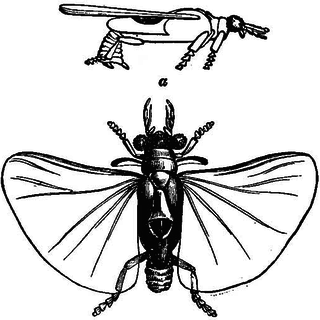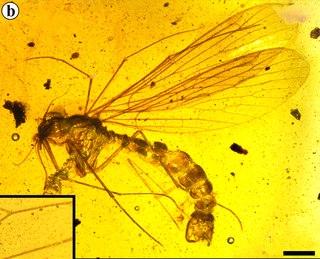Related Research Articles

Mecoptera are an order of insects in the superorder Endopterygota with about six hundred species in nine families worldwide. Mecopterans are sometimes called scorpionflies after their largest family, Panorpidae, in which the males have enlarged genitals that look similar to the stingers of scorpions, and long beaklike rostra. The Bittacidae, or hangingflies, are another prominent family and are known for their elaborate mating rituals, in which females choose mates based on the quality of gift prey offered to them by the males. A smaller group is the snow scorpionflies, family Boreidae, adults of which are sometimes seen walking on snowfields. In contrast, the majority of species in the order inhabit moist environments in tropical locations.

Bittacidae is a family of scorpionflies commonly called hangingflies or hanging scorpionflies.

The Panorpidae are a family of scorpionflies containing more than 480 species. The family is the largest family in Mecoptera, covering approximately 70% species of the order. Species range between 9–25 mm long.
The Panorpodidae are a small family of scorpionflies. Of the two genera, Brachypanorpa occurs only in the United States, and Panorpodes occurs in Japan and Korea, with a species described in 2004 from California.

Stylopidae is a family of twisted-winged insects in the order Strepsiptera. There are about 15 genera and more than 330 described species in Stylopidae.
Cupes is a genus of beetles in the family Cupedidae. The Cupedidae are typical “reticulate” or “net-winged” beetles with incompletely sclerotized elytra that produce the characteristic reticulate appearance.

Prehistoric Lepidoptera are both butterflies and moths that lived before recorded history. The fossil record for Lepidoptera is lacking in comparison to other winged species, and tending not to be as common as some other insects in the habitats that are most conducive to fossilization, such as lakes and ponds, and their juvenile stage has only the head capsule as a hard part that might be preserved. Yet there are fossils, some preserved in amber and some in very fine sediments. Leaf mines are also seen in fossil leaves, although the interpretation of them is tricky. Putative fossil stem group representatives of Amphiesmenoptera are known from the Triassic.
Microperittia is an extinct genus of moths in the family Elachistidae. It was described by Kozlov in 1987. It contains the species M. proboscifera, which was described from Baltic amber, more specifically Priabonian terrestrial amber in the Russian Federation.

Paraneuretus is an extinct genus of formicid in the ant subfamily Aneuretinae known from fossils found in Asia and Europe. The genus contains three middle to late Eocene age species, Paraneuretus dubovikoffi, Paraneuretus longicornis, and Paraneuretus tornquisti.

Dicerapanorpa is a genus of scorpionflies endemic to China. They can be easily recognized by the two anal horns on the posterior margin of the sixth tergum in males.
Formica biamoensis is an extinct species of formicid in the ant subfamily Formicinae known from fossils found in eastern Asia.
Pachycondyla oligocenica is an extinct species of formicid in the ant subfamily Ponerinae known from a fossil found in eastern Asia.
Proceratium petrosum is an extinct species of formicid in the ant subfamily Proceratiinae known from a fossil found in eastern Asia.

Nylanderia pygmaea is an extinct species of formicid in the ant subfamily Formicinae known from fossils found in the Baltic region.
Brachypanorpa oregonensis is a species of scorpionflies, hangingflies, etc. in the family Panorpodidae. It is found in North America.
Brachypanorpa is a genus of scorpionflies, hangingflies, etc. in the family Panorpodidae. There are about five described species in Brachypanorpa.
Brachypanorpa sacajawea is a species of scorpionflies, hangingflies, etc. in the family Panorpodidae. It is found in North America.
Brachypanorpa carolinensis, the short-nosed scorpionfly, is a species of scorpionflies, hangingflies, etc. in the family Panorpodidae. It is found in North America.

Pseudopolycentropodidae is an extinct family of scorpionflies known from the Mesozoic. Fossils are known from the Middle Triassic (Anisian) to the early Late Cretaceous (Cenomanian). It is part of Mesopsychoidea, a group of scorpionflies with siphonate proboscis. They are suggested to have been nectarivores, feeding off the liquid pollination drops and acting as pollinators for now extinct insect pollinated gymnosperms such as Bennettitales.

Aneuretopsychidae is an extinct family of scorpionflies known from the Mesozoic. Fossils are known from the Jurassic (Callovian-Oxfordian) to the early Late Cretaceous (Cenomanian). It is part of Mesopsychoidea, a group of scorpionflies with siphonate proboscis. They are suggested to have been nectarivores, feeding off the liquid pollination drops of and acting as pollinators for now extinct insect pollinated gymnosperms such as Bennettitales.
References
- ↑ Zhong, W., Zhang, J.-X., & Hua, B.-Z. (2011). "Panorpodes kuandianensis, a new species of short-faced scorpionflies (Mecoptera, Panorpodidae) from Liaoning, China." Zootaxa 2921: 47-55.